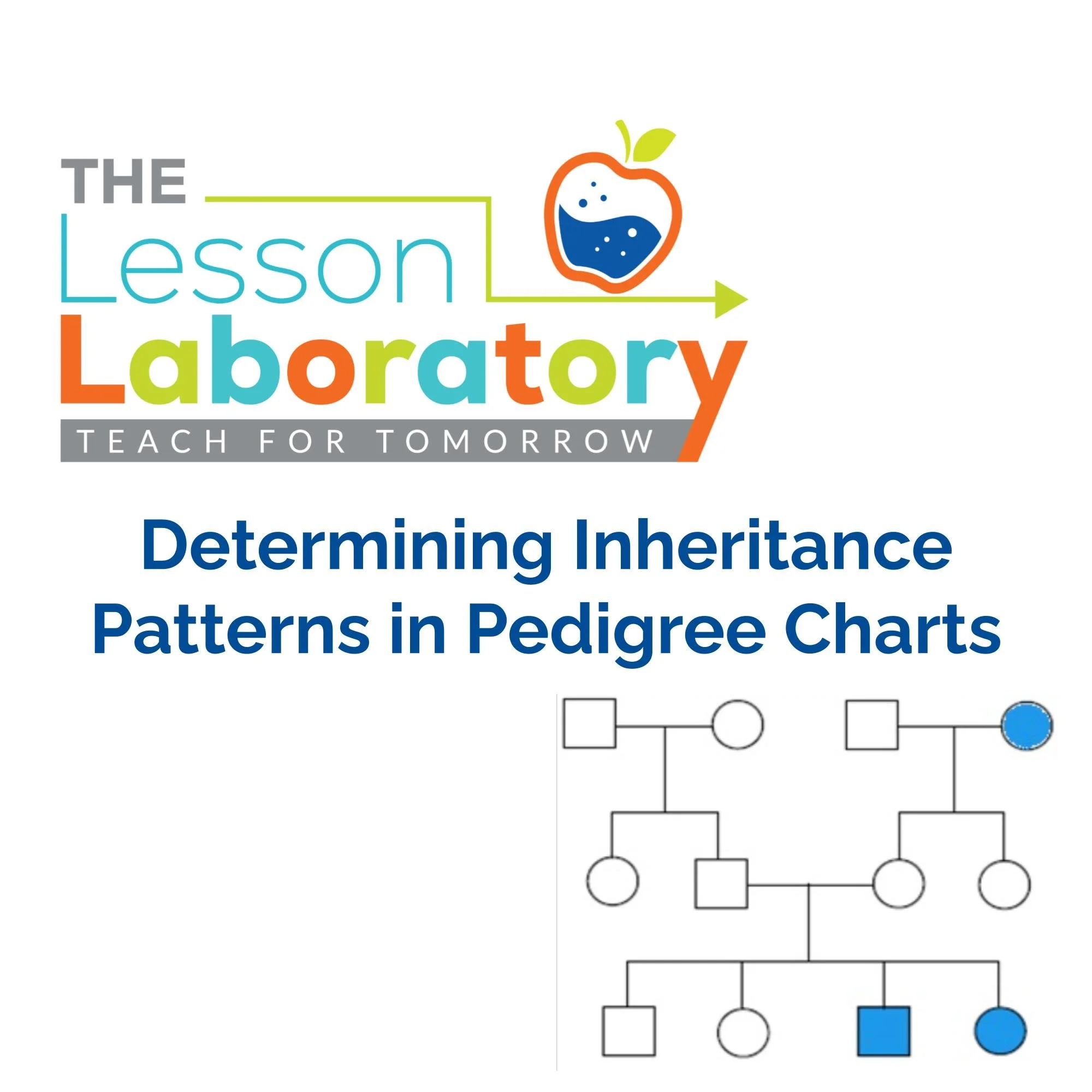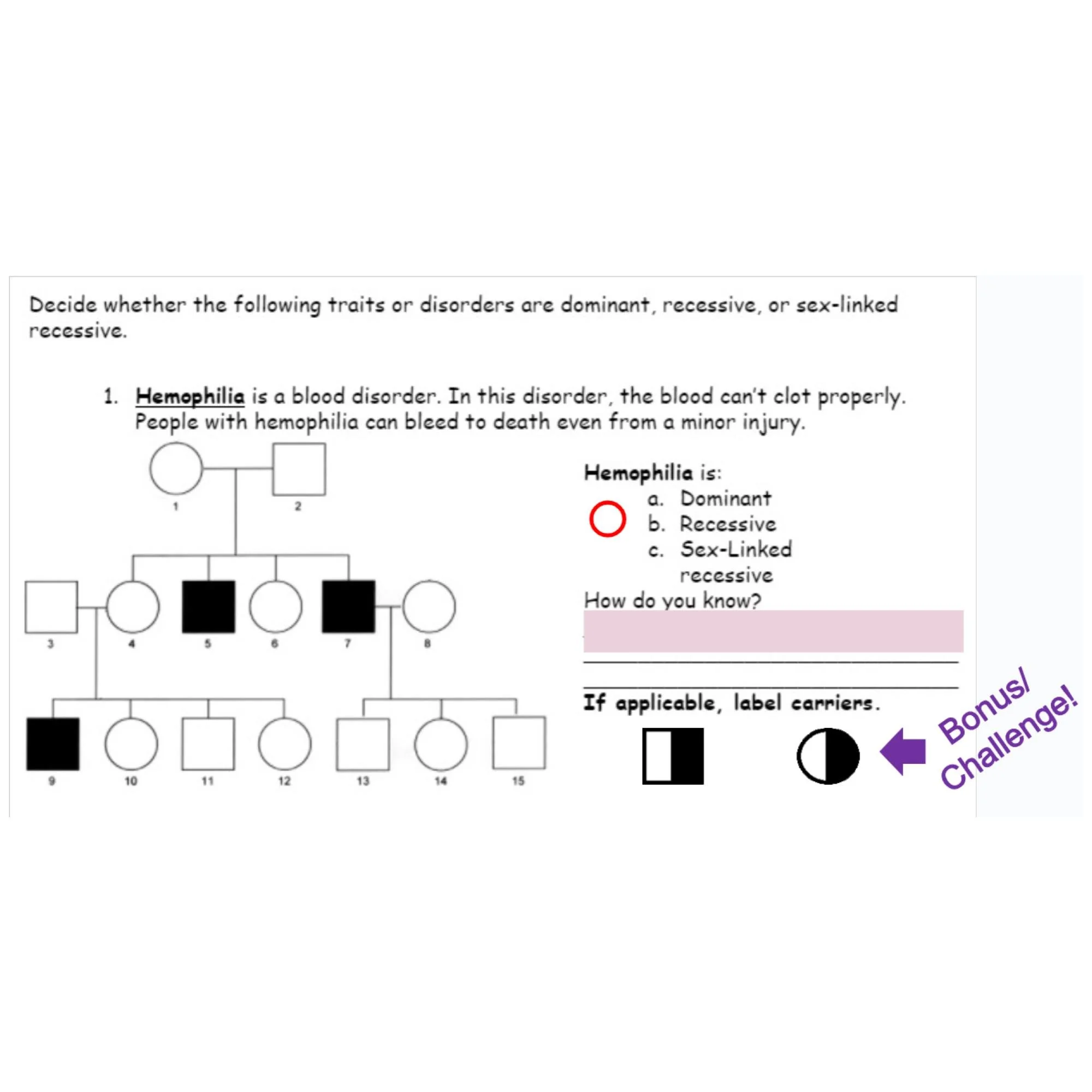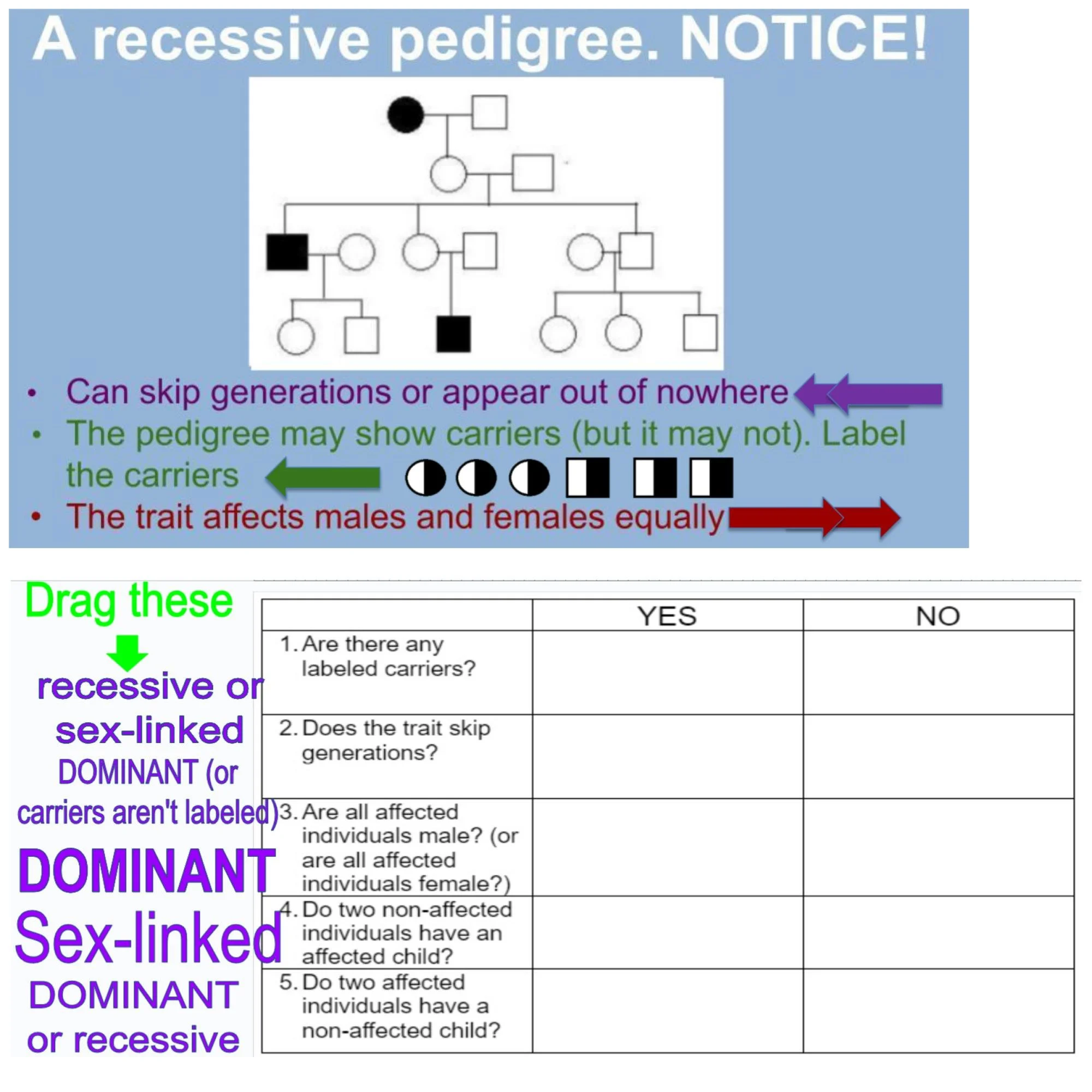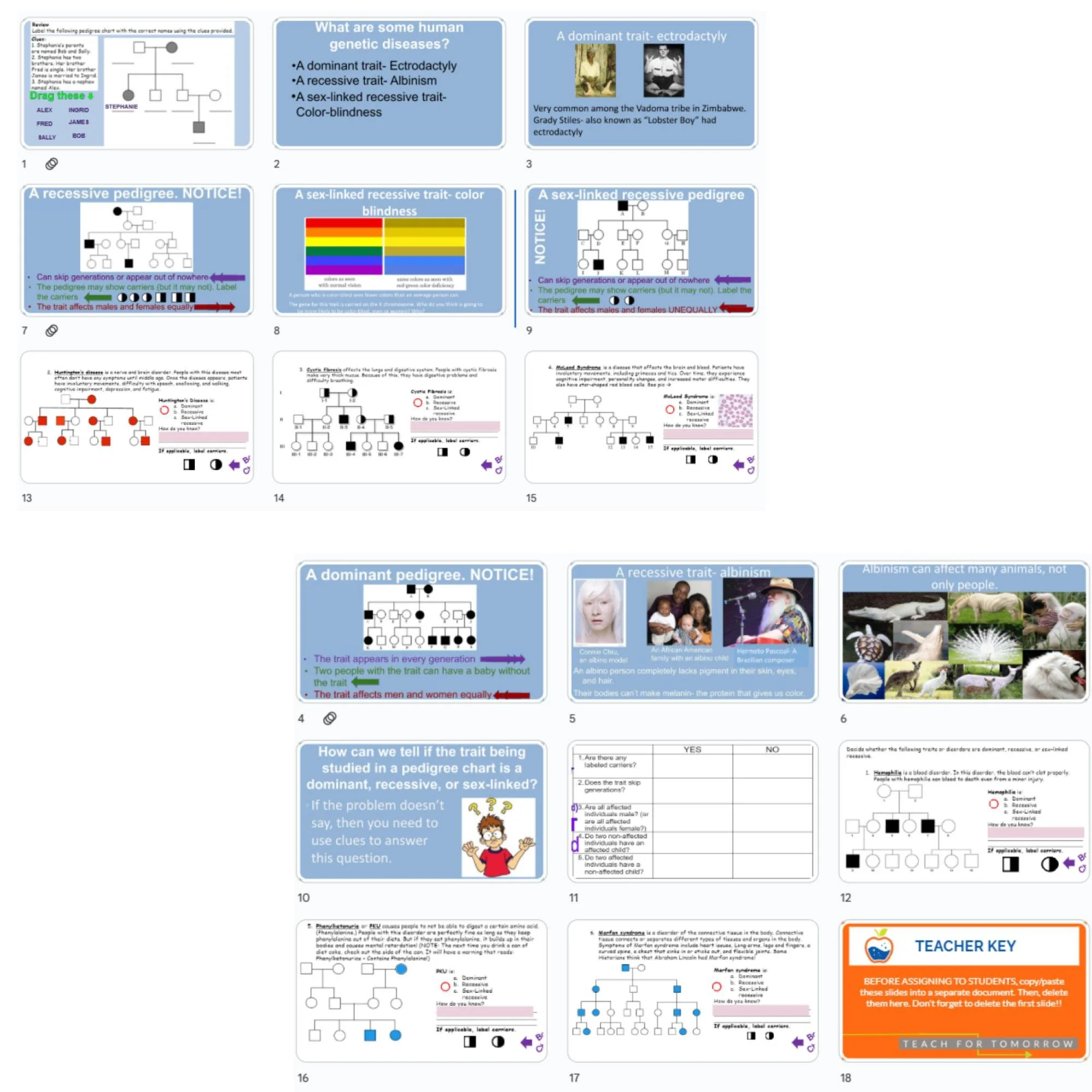



Determining Inheritance Patterns in Pedigree Charts
Unlock the Secrets of Pedigree Charts with this Engaging Google Slides Lesson!
Comprehensive Pedigree Chart Mastery: This interactive lesson is designed to empower students with the skills to decipher pedigree charts confidently. It covers three fundamental types of inheritance patterns: simple dominant traits, simple recessive traits, and sex-linked recessive traits. These traits, all pertaining to real human conditions, provide students with tangible examples to enhance their understanding.
Clarity in Complex Charts: The lesson begins by introducing students to three human traits—ectrodactyly (dominant), albinism (recessive), and color blindness (sex-linked recessive). Students actively engage with these traits by placing arrows on a pedigree chart to indicate key clues for identifying the inheritance pattern. This foundational exercise equips students with a structured approach to decoding any pedigree chart.
Strategic Thinking: To further reinforce their grasp of inheritance patterns, students fill in a chart of clues that guide them in making determinations based on the given information. This step encourages critical thinking and reinforces the principles needed to analyze pedigrees effectively.
Hands-On Application: With their newfound knowledge and skills, students are presented with six additional pedigree examples showcasing real human traits. For each scenario, they determine the inheritance pattern, providing them with practical experience in applying their acquired expertise.
Empowering Learning: Download this dynamic lesson now to empower your students with the ability to decipher pedigree charts confidently. Whether used for remote or in-person learning, this resource demystifies the complexities of inheritance patterns, fostering a deeper understanding of genetics. Elevate your students' learning experience and equip them for success!
Grade & Course Recommendation:
Middle School: Advanced Grade 8 life science course with prior exposure to Punnett squares.
High School: Core Grade 9–10 biology genetics unit resource.
Cross-Curricular Connections:
Math Integration: Probability calculations for inheritance patterns.
ELA Integration: Constructing explanations and defending claims using data.
History of Science: Introduce Mendel’s work as foundational context.
Daily slide + literacy - based exit ticket included with purchase
Join the Lesson Laboratory and Teach for Tomorrow!
NGSS (Next Generation Science Standards)
HS-LS3-1: Ask questions to clarify relationships about the role of DNA and chromosomes in coding the instructions for characteristic traits passed from parents to offspring.
HS-LS3-2: Make and defend a claim based on evidence that inheritable genetic variations may result from new genetic combinations through meiosis, errors during replication, and/or mutations caused by environmental factors. (connection: using pedigree charts to identify inheritance mechanisms and genetic variations)
HS-LS3-3: Apply concepts of statistics and probability to explain the variation and distribution of expressed traits in a population. (connection: interpreting patterns of inheritance, dominant/recessive traits, and carrier frequencies)
Science & Engineering Practices: Analyzing and interpreting data; Constructing explanations; Engaging in argument from evidence.
Crosscutting Concepts: Cause and effect; Patterns; Structure and function.
Common Core Standards
CCSS.ELA-LITERACY.RST.9-10.4: Determine the meaning of domain-specific vocabulary relevant to genetics and heredity.
CCSS.ELA-LITERACY.RST.9-10.7: Integrate quantitative or technical information expressed in words with visual data (e.g., combining textual clues with chart analysis to infer inheritance mode).
CCSS.ELA-LITERACY.WHST.9-10.2: Write informative/explanatory texts to convey complex scientific ideas clearly and accurately (e.g., summarizing evidence for a particular inheritance pattern).
Unlock the Secrets of Pedigree Charts with this Engaging Google Slides Lesson!
Comprehensive Pedigree Chart Mastery: This interactive lesson is designed to empower students with the skills to decipher pedigree charts confidently. It covers three fundamental types of inheritance patterns: simple dominant traits, simple recessive traits, and sex-linked recessive traits. These traits, all pertaining to real human conditions, provide students with tangible examples to enhance their understanding.
Clarity in Complex Charts: The lesson begins by introducing students to three human traits—ectrodactyly (dominant), albinism (recessive), and color blindness (sex-linked recessive). Students actively engage with these traits by placing arrows on a pedigree chart to indicate key clues for identifying the inheritance pattern. This foundational exercise equips students with a structured approach to decoding any pedigree chart.
Strategic Thinking: To further reinforce their grasp of inheritance patterns, students fill in a chart of clues that guide them in making determinations based on the given information. This step encourages critical thinking and reinforces the principles needed to analyze pedigrees effectively.
Hands-On Application: With their newfound knowledge and skills, students are presented with six additional pedigree examples showcasing real human traits. For each scenario, they determine the inheritance pattern, providing them with practical experience in applying their acquired expertise.
Empowering Learning: Download this dynamic lesson now to empower your students with the ability to decipher pedigree charts confidently. Whether used for remote or in-person learning, this resource demystifies the complexities of inheritance patterns, fostering a deeper understanding of genetics. Elevate your students' learning experience and equip them for success!
Grade & Course Recommendation:
Middle School: Advanced Grade 8 life science course with prior exposure to Punnett squares.
High School: Core Grade 9–10 biology genetics unit resource.
Cross-Curricular Connections:
Math Integration: Probability calculations for inheritance patterns.
ELA Integration: Constructing explanations and defending claims using data.
History of Science: Introduce Mendel’s work as foundational context.
Daily slide + literacy - based exit ticket included with purchase
Join the Lesson Laboratory and Teach for Tomorrow!
NGSS (Next Generation Science Standards)
HS-LS3-1: Ask questions to clarify relationships about the role of DNA and chromosomes in coding the instructions for characteristic traits passed from parents to offspring.
HS-LS3-2: Make and defend a claim based on evidence that inheritable genetic variations may result from new genetic combinations through meiosis, errors during replication, and/or mutations caused by environmental factors. (connection: using pedigree charts to identify inheritance mechanisms and genetic variations)
HS-LS3-3: Apply concepts of statistics and probability to explain the variation and distribution of expressed traits in a population. (connection: interpreting patterns of inheritance, dominant/recessive traits, and carrier frequencies)
Science & Engineering Practices: Analyzing and interpreting data; Constructing explanations; Engaging in argument from evidence.
Crosscutting Concepts: Cause and effect; Patterns; Structure and function.
Common Core Standards
CCSS.ELA-LITERACY.RST.9-10.4: Determine the meaning of domain-specific vocabulary relevant to genetics and heredity.
CCSS.ELA-LITERACY.RST.9-10.7: Integrate quantitative or technical information expressed in words with visual data (e.g., combining textual clues with chart analysis to infer inheritance mode).
CCSS.ELA-LITERACY.WHST.9-10.2: Write informative/explanatory texts to convey complex scientific ideas clearly and accurately (e.g., summarizing evidence for a particular inheritance pattern).